

Last Chair: The Ski Utah Podcast
Ski Utah
Ski Utah's new Last Chair will take you inside Utah's resorts for the story behind the Greatest Snow on Earth®. In a weekly series of audio features, host Tom Kelly will bring you behind the scenes with resort leaders, athletes and fascinating figures who are the stories inside Utah skiing and snowboarding. Whether you're a passionate local snow rider, or a guest to the Utah mountain landscape, you'll learn about mountain life through the stories of the men and women who shape the Ski Utah experience. Each Last Chair episode is 30-40 minutes, with insightful questions and fun anecdotal facts. As a career communicator, Kelly weaves stories with ease bringing listeners inside the mountain tales of Utah skiing and snowboarding.
Episodes
Mentioned books

Dec 15, 2021 • 46min
SE3:EP6 - Kristen Ulmer: Embracing Fear
A New Hampshire native, Ulmer discovered skiing as a young girl, skipping school to hit the slopes at lunch time. Friends told her about skiing in Utah. Her mom found a $40 one-way airline ticket. And she headed west, making Salt Lake City her home. She spent every waking moment skiing the bumps at Snowbird.Her breakthrough came after an all-day drive out I-80 to California, sleeping overnight freezing in her car in a ski area parking lot, then hucking herself off a huge cliff doing a trick she had never attempted. She didn’t know it at the time, but she had found fear, embraced it and danced with fear to become one of the world’s most well known big mountain skiers and film stars, with her image beaming from the covers of ski magazines.Today, Ulmer is a thought leader, high performance facilitator, and fear/anxiety expert who draws from her tenure as the best woman extreme skier in the world, studying Zen and from facilitating thousands of clients.What is it about fear that oftentimes defines what we do, or don’t do? What does it take to become fearless (Ulmer says it isn’t possible, so don’t try). And how can we improve our lives, and our skiing, if we simply embrace fear?Ulmer still lives in the Salt Lake City foothills and channels her energy into helping others. Her book, The Art of Fear, is a fascinating look into how you, as a business leader, skier or everyday human, can embrace fear. Her on-snow camps (which, by the way, sell out) counsel skiers and riders on how they, too, can embrace fear to improve their skiing.She’s worked with the likes of free solo climber Alex Hannawald to big wave surfer Laird Hamilton. But she also loves working with everyday skiers and riders - just like you and I!Kristen Ulmer is one of the truly fascinating figures in the landscape of Utah skiing. This episode of Last Chair is a fascinating insight into a Hall of Fame skier whose understanding of embracing fear has shaped her life and the lives of those around her.How did you get into skiing?I grew up in New Hampshire in a small town - Pat's Peak ski area, 700 vertical feet. I grew up in a house that was built in 1786 and it hadn't been remodeled. Now think about that for a sec. I just went skiing with my girlfriends because that's what they did. And then right around age 15, 16, I became really into skiing and I would skip out of school to go skiing during lunch breaks. And then I finally got caught my senior year. I almost didn't get to graduate because I had so many detentions from skipping school to go skiing. But I skied in jeans until I was 20 years old.What motivated you to get into skiing as a career?I had absolutely no goals whatsoever, and this is probably one of the strangest things about my ski career. I also was like the last person to be chosen for elementary and high school, not just soccer, but sports teams - like I was not athletic at all, and I just was obsessed with skiing when I moved to Snowbird in Utah. I started hanging out with a bunch of people that were competing in moguls, and I just wanted to hang out with them and go on road trips. So that's why I started competing.What does it mean to be fearless?People misunderstand people they admire who do incredibly scary things, whether it be skiing or people who run the world or, you know, businessmen and women - people that take incredible risks in any way, shape or form. We have this perception and this ideology that these people are fearless and that is not the case. Nobody's fearless. When I first became a fear expert, I Googled it and I realized that there's no other people out there that are willing to call themselves fear experts because we assume that people that are fear experts, A, are fearless and B, can teach other people how to be fearless. And I am neither of those. Nobody's fearless. It's not only impossible, but it's undesirable.Did you feel fear when you hucked that first cliff in front of the cameras?Well, you'd think that fear would be going through somebody's mind. It never even occurred to me to be afraid that day. And you know, it's a pretty big cliff - your first cliff. And to do a back scratcher, which you've never done, mind you, in front of a whole bunch of very famous skiers that were in all the magazines and, you know, film stars like, you'd think that I would have been a little bit afraid, but I wasn't.Learn more about how you can embrace fear. Check out more with Kristen Ulmer on Last Chair: The Ski Utah Podcast presented by High West Distillery on your favorite podcast platform. Subscribe to get first access to every episode.
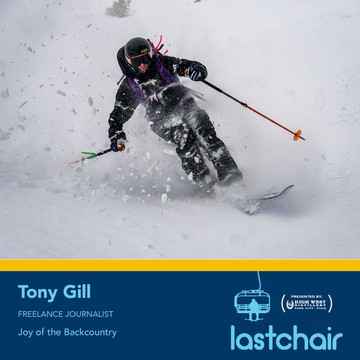
Dec 6, 2021 • 37min
SE3:EP5 - Tony Gill: Joy of the Backcountry
Cruising through knee deep powder in the peace and solitude of the Utah backcountry is pure joy. It’s alluring. It can also be dangerous if you are not well prepared. Journalist Tony Gill grew up skiing on 300-foot ski hills in the midwest. Today, you’ll find him on his telemark skis in the Utah backcountry. He’ll talk us through the joy of having a powder slope to yourself, as well as how to best prepare.
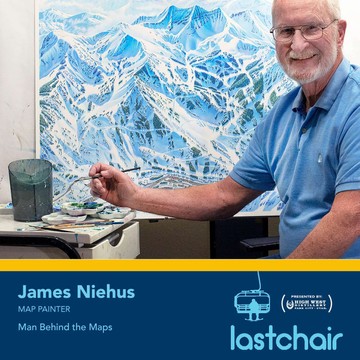
Nov 28, 2021 • 42min
SE3:EP4 - James Niehues: Man Behind the Maps
We’ve all fantasized about our trips to the mountain by poring over detailed trail maps, plotting out each run of our ski vacation. The man behind those maps, James Niehues, has become somewhat of a cult hero in the sport after three decades documenting hundreds of resorts worldwide, painting each and every tree and showcasing perspective to make mountains bigger than life. Last Chair caught up with him at his art studio to learn more about his fascinating career and new book, Man Behind the Maps.As a graphical designer in the ‘90s, Niehues was looking for a change in direction. He had grown up in western Colorado, not really as a skier but someone who appreciated the sport. He had left an advertising business in Grand Junction and moved to Denver. He had followed the work of Hal Shelton and, more currently, Bill Brown and the captivating trail maps they developed. So he tracked down Brown, got a test assignment and ultimately took over as the ski map painter of the time. As he neared retirement a few years ago, friends urged him to document his life in a book. A fundraising campaign got the project off the ground. And the result is a keepsake every skier is going to want to have.Last Chair caught up with Niehues in his studio, finishing up on projects and trying to keep up with the fan mail his book Man Behind the Maps has generated. In the interview he details his life as an artist and walks through the dramatically detailed process of creating a trail map painting from aerial photography to projecting onto canvas, airbrushing shading and painting in every tree - starting with the shadows!It’s a fascinating look into an unlikely sport hero who has brought so much joy to tens of millions of skiers worldwide in his career.
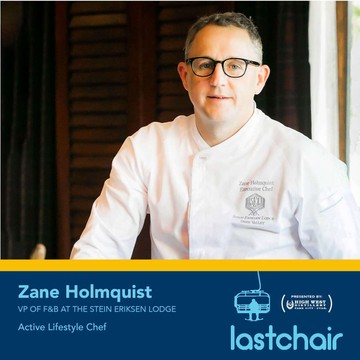
Nov 5, 2021 • 44min
SE3:EP3 - Zane Holmquist: Active Lifestyle Chef
From wild game chili to Stein Burgers and Swedish meatballs with mashed potatoes, Chef Zane Holmquist has served it all. The Stein Eriksen Lodge VP of food and beverage, who grew up in Utah, oversees one of the most highly acclaimed dining rooms in skiing, but is just as much at home on his mountain bike, skis or in triathlons around the world.

Oct 21, 2021 • 41min
SE3:EP2 - Jeremy Jones: Passion for Protecting Winter
Growing up on Cape Cod, it may seem unusual that young Jeremy Jones gravitated towards sliding on snow. But family ski outings led to his passion for snowboarding. Today, Jones is one of the world’s most well known names in big mountain snowboarding. But as he saw his season shortened and glaciers receding, he decided to fight back. He started Protect Our Winters in 2007, uniting skiers and snowboarders in the fight against climate change. Today, POW has become a driving force for systemic change.While Jones finds his true home in the mountains, he has become comfortable in Washington, speaking to Congress and advocating for legislation. His background in storytelling and film has led him to pushing his message out in features like the 2020 release of Purple Mountains.Here’s a sample of what you’ll learn in this episode of Last Chair with Jeremy Jones.Jeremy you’re one of the planet’s most well-known big mountain riders. How did it all begin?My parents fell in love with the mountains later in life, and they basically started dragging my brothers and I. We grew up on Cape Cod, Massachusetts. We would go up to Vermont, where my grandfather had a house (Stowe). I think that it's probably just the creativity of it and that connection with nature and it's always changing, you know, just overtook my life and still has to this day.What first triggered your awareness of climate change?As a teen, I remember that we always had a newspaper at the table in the morning. I saw global warming in the paper and I was like, ‘I don't like the sounds of that.’ At that point I was snowboarding the golf courses on Cape Cod, and I'm like, ‘why doesn't it snow anymore? It always piqued my interest because I never liked the sounds of global warming.How is Protect Our Winters making a difference?At Protect Our Winters we only have so much energy, so we have to focus on the big levers. Large scale CO2 reduction needs to happen through policy. We're not going to recycle our way out of this climate mess is the reality. And that's why we focus our attention at Protect Our Winters on policy. It’s understanding who your elected officials are, what their stance is on climate.Check out more with Jeremy Jones on Last Chair: The Ski Utah Podcast presented by High West Distillery on your favorite podcast platform. Subscribe to get first access to every episode.
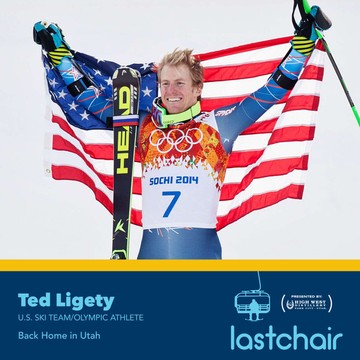
Oct 8, 2021 • 49min
S3:EP1 - Ted Ligety: Back Home in Utah
Over the past two decades, Utah native Ted Ligety has hopscotched across five continents every year, collecting World Cup crystal globes and Olympic gold medals. This winter, he's back home in Utah! Last Chair kicks off season three with an in-depth interview with Utah's own Olympic champion.Check out these stats: 25 World Cup wins, five crystal globes, five World Championship titles and two Olympic gold medals. Not a bad career for the Utah native.With a growing family (wife Mia and three sons) back home and his Utah-based global business, Shred, Ligety decided to retire last February. And he's anxious to make a few fun runs of his own on the slopes of Utah's Deer Valley Resort this winter.This blockbuster season three opening episode of Last Chair will introduce you to the Park City native and take you inside his view of skiing. Here's some of what's in store on Last Chair.Some of his own faves for skiing in Utah.How an Olympic defeat in 2010 inspired him to the greatest years of his career. His favorite GoPro edit. From an athlete who's skied in over 50 countries, his global favorites. His best date night dinner back home. And, of course, his favorite High West whiskey.How old were you when mom and dad trusted you to be on your own at the resort?I think it was pretty young, probably like five or six years old. So I tell that to my wife, Mia, and she's like, 'No way! We're not leaving Jax to the mountain like next year or the year after. But yeah, like, I think when I was seven, maybe eight, I would take my younger brother - so pretty young age ripping around the mountains. And it was fun. I mean, it's such an awesome way to grow up and explore.Ted, you weren't viewed as a future star as a junior racer. Did hard work make the difference?One hundred percent! What was good about not being dominant at a young age was that I had to work harder. I had that work ethic instilled, had that hunger instilled in me. I was forced to take risks and explore and ask different questions than guys that were good. You're now a ski ambassador for Deer Valley, a role Stein Eriksen held for many years. What do you remember of him from growing up here?I grew up skiing in Deer Valley and watching Stein ski, and it was funny. As a kid you would kind of make fun of Stein's style - he had a very distinct style. I skied with him on the NASTAR course once when I was probably like 14 years old. all of a sudden he was like, wham, right into amodern race stance and like beating all of us 13, 14 year olds. And he was probably in his 70s then. Stein was still a competitive guy even even later on. And, you know, he was an inspiration, for sure, growing up here.Ted, what's the spirit that motivates you?"I love just being out in the outdoors, being in the mountains, especially when there's snow on them. It's like a cleansing feeling being out there - this freedom to go fast, ski down a hill, the wind in your face. It's exhilarating. It's just magical being on the mountains,Check out more with Ted Ligety on Last Chair: The Ski Utah Podcast presented by High West Distillery and Saloon on your favorite podcast platform. Subscribe to get first access to every episode.Ted Ligety by the Numbers25 World Cup winsFive World Cup crystal globesFive World Championship medalsGrowing up in Utah, Ted Ligety was influenced by great champions like Stein Eriksen. In 2013, he matched the record of three gold medals in one World Championship, a mark held by Eriksen, Toni Sailer and Jean-Claude Killy. A pretty prestigious group of champions for the kid from Park City. (Tom Kelly)
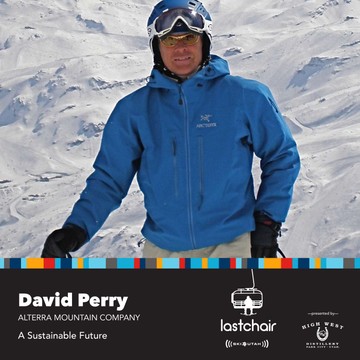
Apr 8, 2021 • 1h 4min
S2:EP16 - David Perry: A Sustainable Future
As skiers, we all have a responsibility to be good stewards of the mountains we ride. Sustainability is vital for our future. David Perry, one the ski industry's most knowledgeable advocates for preservation of our mountain resources, sees a true sustainable future - if we can all work together! Ski Utah's Last Chair takes a look into our future and the vital steps we must take now.Perry has spent his entire career on the tops of mountains, from the Canadian Rockies to Colorado. Today he serves as executive vice president, environment, social, governance for Alterra Mountain Company, with resorts around the USA and Canada, including Utah's own Deer Valley Resort and Solitude Mountain Resort. His passion for being a good steward of our mountain landscapes runs deep.While Perry works for Alterra, his impact is broad. In the highly competitive world of ski resorts, one topic brings all skiers and snowboarders together - preserving our environment for the future.When did you really develop your passion for sustainability?I really gained an education about what environmental activism was about when I got to Colorado and realized that, you know what, we've got this pristine natural environment and we're not treating it with enough respect. And we're also, frankly, the true canaries in the coal mine. We are the people in the high mountain places that are witnessing the impacts of climate change firsthand. And that's still the case today, because we know this climate is changing. It's been really difficult to get people's attention on sustainability. But ski area operators, skiers, snowboarders, mountain lovers - they know it's happening.How is the resort industry working together?Our industry association - the National Ski Areas Association - has a really robust roadmap for how to tackle environmental sustainability in our industry. A lot of work's been done. Alterra is a leader, Vail Resorts is really on board as a leader, as well as POWDR Corp and Boyne. We've rallied around a set of action steps that we should all focus upon.What is the outlook 25 years from now?There are two possible futures. The future I like to believe is possible is us coming together within a short number of years, reducing our CO2 emissions and our carbon footprint to a degree where we can slow, stop and then even reverse climate change in the coming years and decades. That's a global effort. But we need to do our part. There's also a picture of the future that I don't like to believe that we're going to allow to happen as human beings. We have the power to clean up our environment, to reduce - get off - our dependency on fossil fuels, reduce the carbon output, reduce CO2 in our atmosphere and stabilize our climate. It's in our hands.In this week's podcast with Alterra leader David Perry, you'll learn about sustainability, plus a lot more about Perry's fascinating connectivity with the sport, the environment and Utah.Who was his early mentor in the Canadian Rockies?How does his hobby tie together his passion for mountain landscapes.How did he lead a mutually beneficial effort for sustainability with a coal mine?If you are a skier, snowboarder or just love life in the mountains, this episode of Last Chair: The Ski Utah Podcast presented by High West Distillery is an important listen for you. You can find Last Chair on your favorite podcast platform. Subscribe to get first access to every episode.Areas of Sustainability FocusThe topic of sustainability is complex. What is the science? How does it impact our future? What can we do about it? David Perry identified several broad areas of engagement - for the resort industry and for each of us as skiers and snowboarders. Listen to Last Chair: The Ski Utah Podcastto learn more.Energy"Number one is energy," said Perry. How can resorts and all of us better use renewable energy? "The move to renewable energy to sustain operations, to run our lifts, our buildings, our snowmaking systems and everything on 100% renewable or create enough energy to offset your energy use. in Utah, Rocky Mountain Power is moving very aggressively to wean the power grid there off of fossil fuels, coal, natural gas fired plants and move to renewables - wind and solar primarily."Climate Action and AdvocacySometimes we need to make our voices heard! "I call it climate action and advocacy," said Perry. "We as mountain enthusiasts and ski areas can use our voice to talk to others to say, 'we've experienced climate change firsthand and we're doing what we can in our town or in our environment to clean it up.'" How can skiers help? Talk to others, talk to your state and federal representatives. Talk with your action and your supporting words.Good Stewards of Our HabitatHow do we protect our habitat? Are we good stewards of our natural resources? "It's everything from water resources to our forest health and habitat, making sure that we are operating our ski areas in our beautiful mountain places really responsibly," said Perry. Resorts watch for run off that can damage wildlife habitat, and monitor forest health for pine beetle epidemics or wildfire danger - impacts of climate change.Recycling is a basic tenet of being a good steward. "Waste reduction, composting and recycling are really critical elements of living a sustainable lifestyle," said Perry. "But we as operators also have to provide that to make it seamless and easy to do. If you go from place to place and there's no obvious place to recycle your glass and aluminum and it all goes in the trash in the landfill, speak up saying, 'why do you not have recycling bins here?'"TransportationSimple as it may sound, car pooling makes a difference. So does taking the bus or advocating for cleaner fuels for buses. "People today have to burn fossil fuels to get to our ski areas, to enjoy their favorite pastime," said Perry. "Are you willing to drive less? Are you willing to look at a hybrid vehicle, an all-electric vehicle as the grid is starting to support that."Expansion of bus service, like was done in Big Cottonwood Canyon, will reduce car traffic. "It's essential we use our mass transit or shared transit options and we have to improve them," said Perry. "That's one way to reduce our fossil fuel burning habits. It's an essential sense of social responsibility."Engaging TogetherEach of us can do our own part by being good stewards of our landscape. Banded to...

Mar 24, 2021 • 55min
S2:EP15 - Kym Buttschardt: Ogden’s Ski Town Renaissance
A group of skiers sat at the bar in the Rooster's B Street Brewery and Taproom, exchanging war stories about their big pow day up at Powder Mountain. On the brightly colored chalk board were the beers of the day, most brewed up in the huge tanks behind the taproom. It was a boisterous atmosphere with a nice blend of skiers, snowboarders and just plain locals all enjoying the lifestyle of the sport.A century ago Ogden was the crossroads of the west as a vital rail junction. Today, it's revitalized as a ski town with 25th street downtown teeming with restaurants and bars, and the outdoor industry calling Ogden home. At the core of Ogden's energization is Kym Buttschardt of Rooster's Brewing Company, who lives and breathes her community.Kym Buttschardt stands high atop Snowbasin with Strawberry in the background in a stunning alpine scene.In the past quarter century, a renaissance has turned Ogden into a thriving ski town. Taking full advantage of the 2002 Olympic leadup, two pioneering mayors and business leaders like Buttschardt, rallied the town. New and innovative tourist-oriented businesses opened downtown. And Ogden became a calling card for leading ski and outdoor industry brands who moved their national operations to the outdoor-oriented town.What was the catalyst for all of this? It's a community that thrives on outdoor recreation, from biking to hiking to kayaking and skiing. From the heart of downtown Ogden, you can drive to Snowbasin, Powder Mountain or Nordic Valley in about 30-35 minutes. Or, take the bus.In this week's podcast with Ogden skier, entrepreneur and community leader Kym Buttschardt, you'll learn:How a World Cup parade signaled big changes in Ogden.Why the outdoor industry found such a home in the city.Which of the original Rooster's brews is still available but only on draft? (think chocolate)Her favorite ski run? (not for the faint of heart)What did you find interesting about skiing when you started out as a young girl in Ogden? Just the freedom of it - the total freedom of it. And just kind of the coolness and I still feel like that as a 50-something year old woman. I just still get such a rush from being outside and breathing the cold air or sitting in the sunshine.How have you seen downtown Ogden evolve since you opened before the Olympics?We were young, in our mid-20s. We were kind of one of the ones who planted our flag. And then what's happened on 25th Street since then is just beautiful to my heart. I love walking out, looking up at the mountains, looking at my neighbor restaurants and friends around there. There's something very special about it.How did the community engineer this renaissance?It really was a combined recruiting effort. We do a lot with a little up here in Ogden. Mayor Godfrey, at the time, had decided, with the input from residents, that the vision of our town was going to be an outdoor adventure place. The GOAL Foundation was born right after the Olympics, which is a big thing for us up here. It's a volunteer organization that can bring all those wonderful events and support them with volunteers. "We just got together with our friends and said, 'how are we going to make this happen?' And we did it together and keep doing it together today.Join us for a beer in the ski town of Ogden in this episode of Last Chair: The Ski Utah Podcastpresented by High West Distillery on your favorite podcast platform. Subscribe to get first access to every episode.Brewmaster Steve Kirkland was employee #1 when Rooster's first opened its doors in 1995. The Chicago-area native still wears a Bears mask but has long settled down in Utah, recognized as one of the best brewers in the state. He made a nice selection of six beers for Last Chair.Bee's Knees Honey Wheat: A light-bodied, crisp ale, slightly sweet with a touch of honey flavor. 5% Alcohol by Volume.Rude Ram Red: A bold, malty, ruby red ale with notes of roasted barley and caramel, perfectly balanced with Loral hops. 7% ABVSnowbasin 80th Anniversary Pale Ale: A special edition beer released for Snowbasin, it's an easy-drinking, copper-colored pale ale with a hint of caramel malt and bright, hoppy finish. 5% ABVOgden Double IPA: A big beer weighing in at 8% ABV, this ale is dominated by hops both bitter and aromatic with finishing notes of pine and tropical fruit.B Street Blackberry Cream Ale: A medium-bodied, 6% beer brewed with blackberry puree added right in the fermenter. This lends a hint of blackberry without overwhelming the palate.Untamed Juicy IPA: A cracker-y malt base is complimented by the citrusy New Zealand Southern Cross hop that is added both in the boil and in the fermenter for an extra punch! 7% ABV.GOAL Foundation: Get Out and LiveOne of the legacies of the 2002 Olympics and Paralympics in Ogden is the GOAL Foundation. It was designed as a catalyst for Ogden's outdoor lifestyle, galvanizing the community and volunteers to support outdoor events. Nearly two decades later, it continues to thrive.
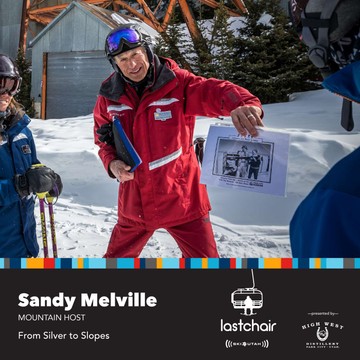
Mar 10, 2021 • 1h 8min
S2:Ep 14 -Sandy Melville: Silver to Slopes
A century and a half ago, Utah's mountains were the home of boomtowns as silver mining flourished across the Wasatch from Little Cottonwood to Big Cottonwood and over Guardsman Pass to Park City. Today, the same slopes that harbored valuable ore are the home of some of the worlds greatest ski resorts. In this episode of Last Chair, skier and mining historian Sandy Melville takes us on a virtual tour of the amazing mining structures that still exist at Park City Mountain.The Bonanza Express base at Park City Mountain is a vital crossroads at the resort. Skiers glide down from the Payday and Town lifts, anxious to make their way uphill. At the same time, others are carving down from Pioneer and McConkey, all congregating at the high speed six-pack. Over a century ago, the location was a vital part of the local economy as hundreds of miners extracted nearly 500 tons of ore a day during Park City's silver boom.For the next few hours, we'll ski back in time to the heydays of silver. Across the mountain west, it's not unusual to find old mines on ski mountains. But it's rare to find the 19th century structures so well preserved. Ski Utah's Last Chair podcast will provide you with a self-guided historical tour around the mountain. And watch for the return of the guided Silver to Slopes tour next season.The mining history here was well over 100 years. And we're fortunate to have so many mining structures left on the mountain intact.In this week's podcast with historian and ski guide Sandy Melville, you'll learn:Craziest question from a mountain guestHow mining and skiing came together in the '60sSandy's favorite High West whiskey brandWhat's the significance of 'apex law'?What role did Dr. Snow play in mining to skiing history?Join us for a step back in time in this episode of Last Chair: The Ski Utah Podcast presented by High West Distillery on your favorite podcast platform. Subscribe to get first access to every episode.Silver to Slopes Virtual TourIt's easy to learn more about Park City Mountain's historical mining sites. Here's an easy-to-follow tour, with interpretive signs at each stop.+View easy-to-follow tour mapSilver King Coalition MineStart at the Park City Mountain base on Payday Express, or downtown Park City on the Town Lift. From there, simply ski down to the Bonanza Express and you'll find yourself in the midst of the old Silver King mine, the most viewed mining site on the mountain.The Silver King was one Park City's 'big three' mines with claims developed in the 1880s and incorporated in 1892. An aerial tramway was added in 1901 to transport ore down to the railroad. The shaft closed in 1953 as metal prices declined. In its day, it was a hugely profitable mine.In the mid-70s the buildings of the Silver King Mine were used for several years as a training center for the U.S. Ski Team. The center didn't work out well, but the team has remained in Park City, where it still makes its home today. In 1987, the huge boarding house was moved 500 vertical feet uphill to its present location as Mid Mountain Lodge just above the Pioneer and McConkey lifts.In a mid-60s view from the original Treasure Mountains gondola, the remnants of the Silver King mine sprawl around the area presently occupied by the Bonanza Express lift.Silver to Slopes guide Sandy Melville displays two ore samples - one contains silver, one is, well, just a rock.California-Comstock MineFrom the Silver King Mine, take the Bonanza Express six-pack up the mountain. Then ski down Homerun to Mid Mountain Meadows, skiing towards the historic Mid Mountain Lodge then hop onto Pioneer. From the top of Pioneer, ski down Keystone. Don't go too fast. About two-thirds of the way down, look down to the rising slope on the other side of Thaynes Canyon to see the California-Comstock Mine.In the late 1800s, the two neighboring mines tended to have conflict on who owned what once they were underground. The Comstock Mine was incorporated in London in 1882. By 1890 it had a boardinghouse for 50 men on site. The California Mine was incorporated in 1897. By 1905, the two had merged. Unlike the Silver King, the mine location was quite a long ways away from the railroad, with travel on dirt roads. It was acquired by King Con in 1918 and then to Silver King Coalition in 1924.Today, the remaining structure is one of the most photographed on the mountain. It's aging beams and gorgeous masonry was stabilized in recent years by Friends of Ski Mountain Mining History and Vail Resorts, as well as recovering a huge stone crusherThaynes Shaft Just a few hundred meters down the canyon is one of the most spectacular sites on the mountain, the Thaynes Shaft. To get up close, you can cut through the woods off Keystone or Thaynes Canyon just after California-Comstock.The Thaynes complex is one of the newer of the old mines, with the shaft sunk in 1937 by Silver King Coalition to reach the Spiro Tunnel. The work was based on depression-era incentives from President Franklin D. Roosevelt. It was one of many mines in Thaynes Canyon that were productive, but its shaft was closed to mining in 1947.To exit, just slide over the Thaynes lift or continue on down the canyon to either Motherlode or King Con.The Thaynes Shaft was one of many mines in Thaynes Canyon, which connects the Jupiter, Thaynes, Motherlode and King Con lifts.Skier SubwayOne of the fascinating 'modern day' use of the Thaynes Shaft was its role in the famed Skier's Subway operated for four seasons beginning in 1965. Skiers would board mine cars at the Spiro Tunnel (at today's Silver Star base area), riding three miles into the mountain then riding the Thaynes Shaft elevator 1,700 feet up to the base of the Thaynes lift.An innovative concept from the mining company to get skiers back to the new chairlift, it was fraught with problems and wasn't the most pleasant experience for skiers. Today you can visit the Spiro Tunnel opening at the Silver Star base and see the exit point next to the Thaynes lift.Preserving Mining HistoryThe preservation of mining history is an important cause in the Park City community. The silver mining heritage is an important piece of the town's history. At the Park City Museum on historic Main Street, you can relive the mining days and even see an actual Skier Subway ore car.An offshoot of the Park City Museum, the Friends of Mountain Mining History has been a crucial advocate for preservation of the 20 historic mine structures on Park City's mountain trails. Vail Resorts and Park City Mountain have been valuable partners in the stabilization of the Thaynes conveyor, King Con counterweight, California Comstock mill, and the Jupiter ore bin among other sites.Friends of Ski Mountain Mining HistoryPark City MuseumUtah's
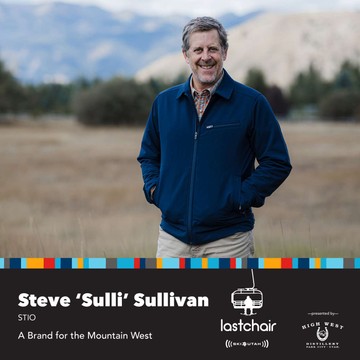
Mar 3, 2021 • 43min
S2:Ep13 - Steve Sullivan: Stio - A Brand for the Mountain West
The outdoor adventure clothing brand Stio has been showing up more and more at Utah ski resorts. Founder Steve ‘Sulli' Sullivan grew up in neighboring Colorado but spent a lot of time in Utah's red rock desert and snow-covered mountains. Today, he puts his passion for the mountain west into the fast-rising Stio brand. He spoke to Last Chair about his love for the outdoors and how it's embodied in his brand.Sullivan was born in the midwest but moved to western Colorado when he was 10. His uncle loved to explore and took him on trips to nearby Moab to explore Canyonlands, getting engaged in hiking and mountain biking - exploring the mountain west landscape. He started hanging around his uncle's girlfriend's outdoor shop, getting a complete immersion in outdoor sport.Working in ski, bike and outdoor shops growing up, at college in Durango and later in Boulder, helped develop his pathway. He put his own stamp on the business starting Cloudveil, and later Stio.Today, Stio has a growing footprint in Utah with a concept store on Park City's historic Main Street, a partnership with Ski Utah and a thriving direct-to-consumer brand that provides him with a flow of customer feedback that fuels product development.The Stio brand is all about outdoor empowerment. Our tagline is let the outside in. It's all about giving people a reason to be outdoors.His interview with Ski Utah's Last Chair podcast provides real insight into the power of the mountain west culture into a brand that is rapidly gaining popularity. Here's just a sample. Listen to Last Chair to learn more.How did you get into the outdoor clothing business?One of the reasons I got into the apparel business was just going through my youth, always being cold and wet and wearing some old hand me downs. But I really learned a lot about the climate. And I became really fascinated about textiles and what different textiles could do to add to your enjoyment and performance in the outdoors.How do the desert and mountains in Utah combine to form such a special lifestyle?The desert is one of the great powers. The mountains, the desert, the oceans - I'm still entranced by it. I've always thought it was a really powerful place and a place of unbelievable changes in climate. I've done a lot of skiing in Moab in the La Sal's. It can be just absolutely superb spring skiing down there. I truly love the desert. I feel like it is one of those powers in the world, like the mountains. One of the coolest things about Utah is you guys have this unbelievable topography - the state is so diverse. It's just amazing. And you have the Wasatch and and the unbelievable mountains up near Salt Lake and then, you know, drive a few hours. And the next thing you know, you're in red rock country.How would you define the mountain west culture?There's just something different about living out here. There's something different about the people. There's something different about having to deal with the elements and the time spent outside, whether that's skiing or climbing or fly fishing or whatever it might be, kayaking, river running in the mountains. There's just a different culture out here. And it's a culture that is just so ingrained in my life and in our company. It makes a huge difference in the types of people that end up in the mountains are real. You have to deal with a lot of adverse weather and a completely different kind of change in seasons constantly. It's super ingrained in our brand because all of our employees live the outdoor lifestyle. There's plenty more in this episode of Last Chair: The Ski Utah Podcast.Sulli's favorite Utah resort.Craziest outdoor activity he's ever undertaken (and there have been many).What he does outside skiing (just about everything)His fave High West brand.Take a listen today. Tune in to Last Chair: The Ski Utah Podcast presented by High West Distillery on your favorite podcast platform. Subscribe to get first access to every episode.About Stio's RootsStio was founded to inspire connection with the outdoors through beautiful, functional products infused with mountain soul. We draw inspiration from our everyday immersion in life here in Jackson Hole: days on local rivers, trails and Teton summits. Technical performance, quality and versatility are hallmarks you'll find in every piece of apparel we make, be it intended for epic alpine pursuits or the quieter moments of the mountain life.Where to find StioStio is a direct-to-consumer brand, available at www.stio.com.You can also visit Stio's shop on Main Street in downtown Park City, Utah.


